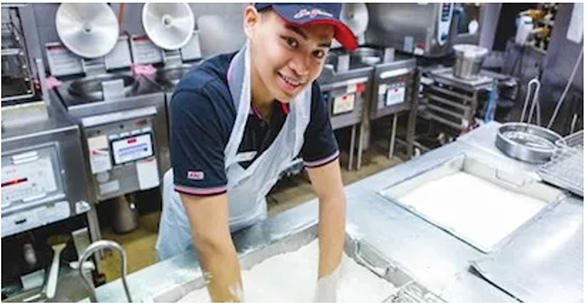big changes in fast-casual
The pandemic, great resignation and eminent recession has brought a wave of change in all segments of the restaurant industry.
The biggest market shift seems to be the rise in off-premise business (e.g. catering, take-out, delivery). At one point there was a question as to whether this would be a passing trend that would subside once things got back to “normal.” As we’re seeing there really isn’t a new normal, at least not yet, and the proclivity for off-premise dining is here to stay.
By their nature, Fast Casual restaurants were, thankfully, already well positioned to do a healthy amount of off-premises business. But, over the past two years as the demand for off-premises food orders increased many fast casuals are still having to adapt.
Initially, one of the driving forces behind Fast Casual was the concept of “food theater”. This successfully emphasized the presentation of quality ingredients and / or focused on food preparation to clearly differentiate from their quick serve rivals. The idea was to combine casual dining quality with quick serve convenience. Emphasizing that quality proposition became critical.
But now, with a higher percentage of business going out the door rather than dining-in and a larger percentage ordering ahead online or via apps, many concepts are having to rethink how that quality statement is communicated. Several notable brands are considering eliminating the food theater or guest/employee interaction or creating a separate operational flow to address the order ahead business.
 For example, Chipotle is highly regarded as a classic scoop-and-serve, quality-ingredient, Fast-Casual concept. The guest goes through the line, places their order at the various stations, and watches their meal be prepared in real-time. Next, they pay for their order at the end of the line before seating, (sometimes referred to as ‘Pay-Last’). While this process has a lower throughput, Pay-Last typically yields a higher ticket average because of the up-close interaction with staff, the ordering process, and visual lure for fresh ingredients.
For example, Chipotle is highly regarded as a classic scoop-and-serve, quality-ingredient, Fast-Casual concept. The guest goes through the line, places their order at the various stations, and watches their meal be prepared in real-time. Next, they pay for their order at the end of the line before seating, (sometimes referred to as ‘Pay-Last’). While this process has a lower throughput, Pay-Last typically yields a higher ticket average because of the up-close interaction with staff, the ordering process, and visual lure for fresh ingredients.
However, if that flow is interrupted by several online or 3rd-party delivery orders, the customer interaction is significantly hampered. So, Chipotle recently introduced a new store format with a second, order ahead focused (non-customer facing), make line so that the two experiences are kept separate. Of course, Chipotle has the scale to make a shift like this, whereas many emerging fast casual chains are struggling to find another answer.
Another factor in the current restaurant climate is many Quick Serve restaurants have gone to Drive-Thru only service. Should Fast-Casual adopt the drive-thru model? How else can they provide the convenience the quests want while also emphasizing quality?
 Another prominent Fast-Casual brand is also exploring these ideas. The restaurant “Chop’t” is now looking at an entirely new format leaving the Pay-Last format in favor of a; ‘contactless ordering’ Pay-First model.
Another prominent Fast-Casual brand is also exploring these ideas. The restaurant “Chop’t” is now looking at an entirely new format leaving the Pay-Last format in favor of a; ‘contactless ordering’ Pay-First model.
The guest experience is different.
Are these restaurants hurting themselves by becoming less oriented to the guest experience and nearly becoming a takeout joint?
Does this create a self-fulfilling prophecy? What do these shifts mean for the Fast-Casual segment? Will it simply be absorbed into the Quick Serve category? Or will they find other ways to make clearly differentiate themselves and make the quality statement?
Fast-Casual has been the fastest growing restaurant segment for many years. How does this shift impact the guest experience and differentiate if order ahead is the driving force? How do you take care of the guests?
Will this work?

From a cost standpoint, many restaurants can only afford a single make-line. Food theater is vital to the concept and eliminating it to gain convenience is not desirable. Most emerging fast casual chains don’t have the footprint, capital or infrastructure to try what Chipotle and Chop’t have done.
So here are some other options to try. The coming year will determine the most effective direction(s).
1. We see a Pay-First format with the queue line running past the staff preparing fresh orders from refrigerated cases displaying fresh ingredients being one way for a single make line to accommodate both the walk-in guest and the order ahead guest efficiently while still emphasizing quality experiences.
2. One thing that several Fast-Casuals are trying is an emphasis on curb-side delivery. Many are using new technology such as apps like FlyBuy, SwipeBy, and Curbspot. You simply drive into the parking lot; the restaurant staff know where you are and promptly bring your order out to you. This eliminates the perception of long waits because there’s no line, and seemingly elevates the level of service above a drive-thru.
3. Another thing we’re seeing that helps to elevate the dine-in experience for Fast-Casual and differentiate it from quick-serve is to brand the pick-up or delivery process. Many chains use runners to bring food to your table, while one emerging chain is asking the guest a whimsical question of the day and calling out their answer when their food is ready at the pick-up counter.
4. Scratch made and / or cook-to-order concepts. We’ve seen so many innovations in cooking equipment that its now possible to provide a true cook-to-order meal in a fast-casual time frame of under 5 minutes. On the other hand, equipment advancements allow for improved product quality with speed and scale that make fresh ‘scratch made’ or ‘in-house made’ specialty items possible with the limited space, labor and skill for the average restaurant.
5. One other option is what we’re seeing in the retail industry. One guest focused A+, flagship location in each major market with several smaller convenience focused supporting locations in-filling around it. The flagship remains guest focused because the majority of the off-premise orders are diverted to the B & C level units.
Perspective
Our perception is that the big players in Fast-Casual are largely moving to address order-ahead business quickly, while not disrupting dine-in business. We expect to see more second make-stations/lines, or movement to Pay-First. In Fast-Casual, maintaining excellent service is of primary importance and this segment may morph into a bifurcated experience. The kitchen and servery are set up for efficiency while the dining area is primed for experience and hospitality.
Food Theater may become secondary, or perhaps a new approach to emphasize quality may be necessary. Food display will become more important with faster, made-to-order concepts vs. cook-and-hold.
The restaurant world is still in a period of transition. Anyone who claims certainty about sure-fire solution may warrant some healthy skepticism. The bottom line is that it’s vital to design with the ability to adjust and flex from the beginning. With intelligent, mindful design, and options that enable flexibility and agility, restaurants will be adaptable to whatever model becomes the prevailing direction in the industry’s future. As the economy shifts, money spend on food and dining changes with it. If there’s only one thing that the pandemic taught us, it’s that the restaurant industry is resilient and seems to always find a way to adapt to adversity.
how to survive the labor shortage
Everything isn’t out of your control! There really are things you can do.
The health crisis and restaurant closures caused by the COVID-19 pandemic are finally starting to wind down. But trouble for the restaurant industry isn’t over yet. Now we find ourselves in an unprecedented labor shortage and the “great resignation.”
With dine-in business picking back up and most off-premise business staying significantly stronger than pre-COVID numbers, there is now a surge in customer / guest demand. Unfortunately, most restaurants are not comfortably meeting that demand. Businessinsider.com quotes a study of 3,000 restaurant operators that found 7 out of 10 operators reported not having enough employees to support the demand at their restaurants.
Most industry experts and economists say that this labor shortage is out of our control, and we just have to learn to live with it. However, there IS something you can do about restaurant labor. And it’s more straightforward than you might think.
Every restaurateur can significantly reduce labor issues by improving the efficiency of their facility and operation to make it easier for their current employees to do their jobs.
They can even decrease the number of staff required at any given time. These improvements have a huge impact on employee turn-over. A friend and former Yum Brands executive told me this story that proves this point.
Several years ago, Yum Brands was struggling with high turnover. From HR’s perspective, they were doing everything right -- they offered market leading wages, time-off, benefits, etc. Yet they still faced higher-than-average turn-over. So, in classic Yum Brands fashion, they did an extensive survey on why people were leaving. What they discovered offers a true paradigm shift from most conventional thinking. They found that most of their employees really wanted to do a good job and excel at their role. But they were being impeded from doing so because equipment, facilities, and technology were sub-standard or simply didn’t work. This led to frustration and ultimately to employee turnover.
So, what if you change YOUR thinking about the labor shortage by leveraging what Yum Brands discovered?
To get started, evaluate your operation, your facilities, your equipment, and your technology. If any of it is sub-standard, outdated or broken, you are giving your valued employees a valid reason to leave and work somewhere else. When Yum shifted to this perspective and made the necessary changes, they went from below average to industry leading employee retention.
Doing this at your restaurant may seem like a daunting task, but it doesn’t have to be.
Restaurant brands across the country can find simple ways to improve all these areas throughout their restaurant portfolio to yield strong returns on relatively small additional investments.
These changes show staff that you’re investing in them and helping them to succeed at their jobs. For example, there are many new innovations in cooking automation, “smart” equipment, and integrated technology that make it much easier and more efficient for minimally skilled employees to produce true quality food and service. I’m not talking about robot pizza makers or tortilla friers, but incremental upgrades to equipment and technology that are appropriate to your operation.
 Let’s look at some concrete examples where these types of improvements made a significant impact on back-of-house labor in two different burger concepts. One concept was using large manually controlled flat griddles to grill their burgers. The second concept previously chargrilled their burgers on a 6’ open chargrill. Two very different styles of cooking burgers that resulted in the same problems:
Let’s look at some concrete examples where these types of improvements made a significant impact on back-of-house labor in two different burger concepts. One concept was using large manually controlled flat griddles to grill their burgers. The second concept previously chargrilled their burgers on a 6’ open chargrill. Two very different styles of cooking burgers that resulted in the same problems:
-
- They both required constant attention from the grill cooks;
- It was almost impossible to achieve consistent results without fairly skilled employees; and
- At busy times, it also required at least 2 grill cooks to keep up with the volume.
To address this, the flat top griddle concept changed to ‘clam shell style’ griddles with solid state controls. The chargrilled concept changed to conveyor type enclosed charbroilers. These fairly simple changes allowed one cook to grill the burgers in almost half the time with flawless consistency. Because the new semi-automated equipment cooks so quickly and accurately without needing constant attention, it allowed both concepts to go from multiple grill cooks down to a single cook who could handle even their highest volumes.
 These changes also reduced the footprint of the grill from 6’ to 4’, which helped tighten up the rest of the cookline. So, one cook can more easily work the entire cookline during off-peak times further reducing the need for skilled labor.
These changes also reduced the footprint of the grill from 6’ to 4’, which helped tighten up the rest of the cookline. So, one cook can more easily work the entire cookline during off-peak times further reducing the need for skilled labor.
In both cases the more advanced automated cooking solutions required about $35,000 - $40,000 higher initial investment. Both paid for themselves in approximately 6-9 months and then generated significant labor savings after that.
To take advantage of these ideas for your own concept, all that’s required is:
-
- A fresh look at your operation;
- Expertise in design and foodservice equipment;
- Unbiased knowledge of these innovative technologies; and
- A methodical approach to determining which are appropriate for your brand.
Making strategic changes such as these isn’t going to create a larger restaurant workforce – that truly is out of anyone’s control. But it WILL help you:
-
- Retain your current staff;
- Make that staff more efficient; and
- Minimize the number of employees you need to efficiently provide great food and service.
In today’s world, that can make all the difference between just getting by vs thriving with a happy customer base.
Starrdesign Designs Firebirds Concept with New Contemporary Look and Feel
Firebirds Wood Fired Grill opens Nov. 9 at 16641 Birkdale Commons Pkwy. in Huntersville at Birkdale Landing, the company said Thursday. The revitalized mixed-use development is across from Birkdale Village.
The 5,600-square-foot Huntersville restaurant opens with a new contemporary look designed by Charlotte-based Starrdesign, according to Firebirds. The open layout features floor-to-ceiling windows, exposed steel, abstract artwork and pops of color with orange, red and teal.
Read More Here:
https://www.charlotteobserver.com/news/business/whats-in-store/article255357966.html
Starrdesign, the nationally recognized restaurant architecture & design firm, is growing again.
starrdesign has announced two new hires, Fredwin Molina and David Harrill, June. After a challenging year for the restaurant industry, starrdesign President, Steve Starr, is optimistic about a new golden age for restaurants and is building his team to prepare for those opportunities.
Steve Starr says, “We’re really excited to be in growth mode again after the pandemic. I’m especially excited to be adding such great people like Fredwin and David to our team. In addition to being burgeoning architects, they’re both fantastic all-around people. I’m already impressed with their willingness to jump right in and make a difference.
Read more here:
https://www.fermag.com/articles/restaurant-design-firm-grows-with-two-new-hires/
[Podcast] The Main Course: How to Build a Holistic Restaurant Concept and Brand
Listen to Steve Starr in The Main Course Podcast with Barbara Castiglia.
While the food and beverage portion of a meal is the main focus, restaurateurs also develop other aspects of the business to create a unique experience. Service is one. The design and layout of a restaurant also matter. Everything from ambiance to color, to sound, and to lighting.On this episode of The Main Course Host, Barbara Castiglia talked with Steve Starr, the Founder and Chief of StarrDesign. The duo spoke about restaurant design, what goes into it and how the pandemic altered how restaurants are approaching their restaurant design. Listen to learn about how Starr feels about good design and operational efficiency deliver guest expectations.
https://open.spotify.com/episode/7nqJCIJRphGCQJPu5m8SzG?si=X31JkYZ4RzSG0UdylJv3VQ&dl_branch=1
Foodservice Equipment Reports: Dedicated order pickup areas help separate off-premise and dine-in business.
Steve Starr, chief/president of Starr Design, recommends operators create a dedicated order pickup station. It’s worth the investment. After the pandemic, he says, off-premise orders will make up 20%-30% of business, up from 10%-15% pre-pandemic. Sign up for the Restaurant Redefined series.
https://www.fermag.com/articles/from-the-editor-balancing-act/
Love at First Bite: Quick-Service Concept Hiya Taco Powered by Back-of-House Cook-Chill System
Foodservice Equipment Report (FER) highlighted how starrdesign helped create the new fast-casual restaurant design for Hiya Taco just outside of Milwaukee. While most traditional taco concepts use a scoop & serve method to meet speed requirements, this method allows the taco fillings to stew in a steamtable for hours. Hiya Taco offers cooked-to-order tacos using a cook-chill-finishing method offering guests exceptional food quality, quick ticket times, and very unique flavor profiles. This new cooking method and the creative design set Hiya Taco up for a multi-unit expansion.
https://www.fermag.com/articles/quick-service-concept-hiya-taco-powered-by-back-of-house-cook-chill-system/
12 Chef-Inspired Recipes To Shake Up Your Quarantine Dining
Tired of making the same few things from your pantry-friendly foods? Even restaurant industry foodies feel like they’re running out of unique ideas to cook for themselves and their families while sheltering in place. So we’re here to spice things up. We reached out to our friends in the restaurant industry for some of their favorite recipes that you can make right in your own home.
Celebrity chefs and professionals with over 140 + combined years in the restaurant industry pitched in some relatively easy recipes that can be made with ingredients that are likely already sitting in your pantry. If not, you can easily find them at a local grocery store (in your mask, of course!).
While we still encourage everyone to support their favorite restaurants with take-out orders much as possible, we understand that it can become a bit taxing on some already tightened purse strings. So dive in and enjoy one of these 12 chef-inspired recipes from the chefs we’ve grown to know and love over our many years together in the restaurant industry – we know we will!

1 Problem, 3 Solutions: A Restauranteur's Guide to Selection & Procurement
As product options and providers increase across the globe, narrowing down restaurant furniture can be difficult. Procurement can be even more difficult, particularly as globalization continues to open doors to new opportunities and to new challenges.
For the purpose of this article we focus on seating, one of the most imported furniture products in the country. It also is one of the most essential, practical parts of restaurant interior design. However, ensuring that you have all of the right seating in time for opening day can be a huge pain in the you-know-what.
Here are a few practices you can take to minimize stress and complications when trying to get the best product into your concept seamlessly and cost-effectively:
Make sure expectations are clear
You should have a clear understanding of what your budget and concept mean for your furniture selection. We categorize seating in terms of the amount of time you intend a guest to sit in the chair (i.e. full-service dining restaurants usually use 45 – 90 minute chairs; whereas fast casual restaurants typically look for 30-45 minute options). If you’re used to “45-minute chair” prices in your casual dining concept, it’s important to note that you’ll need to pay more for a “90-minute chair” that’s suitable for a fine dining experience. Cost often correlates with average time spent in a chair, so it’s important to know how long the average customer will sit. QSR’s typically have a higher volume of shorter seat times, making comfort less important than durability.
 You can also follow this old rule of thumb. If you are looking at wood chairs or stools and have physical sample, you can self-evaluate by looking at its number of mechanical fasteners (i.e. screws, bolts, brackets, etc.). The fewer mechanical fasteners, the higher the quality. When the joints are all wood, the chair is more likely to flex under pressure rather than break.
You can also follow this old rule of thumb. If you are looking at wood chairs or stools and have physical sample, you can self-evaluate by looking at its number of mechanical fasteners (i.e. screws, bolts, brackets, etc.). The fewer mechanical fasteners, the higher the quality. When the joints are all wood, the chair is more likely to flex under pressure rather than break.
Look for properly rated products
BIFMA (The Business and Institutional Furniture Manufacturers Association) is a non-profit organization that sets safety and performance standards for commercial furniture products. It runs stability, durability and safety tests on products from different manufacturers and uses scientifically-backed standards to rate each product. It can be challenging to differentiate between good, better and best quality products by looking at a catalog, despite the huge differences between them and their relative prices. Looking for BIFMA certifications not only provides direction but can also shift liability from you to the manufacturer if the product malfunctions. Although it may increase the cost, BIFMA-rated products are recommended for sustainability in the long run -the higher the rating, the more weight it is designed to support and the more durable it is.
Communication is key
Communication also is essential to mastering the lead time between ordering and receiving your furniture. This includes doing your research to see how long vendors will hold items, how much notice they need before placing an order and making storage arrangements for the products if they arrive before construction is completed.
One way we deal with this is to always include specifications for how and where the General Contractor should store the furniture should it arrive early. This is particularly important in today’s age of globalization, where shipping times can often be unpredictable (foreign countries, typhoons, etc.). Ideally, you want to work it out so that the furniture arrives once the restaurant is ready for it – but this is rarely reality. Therefore, clear communication about when the furniture is needed, how long it takes to ship, how far in advance to make the order and whether you need housing accommodations will help save you from overpaying for air freight or sacrificing design for quick-ship options. Using a purchasing agent or ensuring that your designer can act as a purchasing agent (and is familiar with these issues) can often save you a lot of money and pain in the you-know-what.
Featured in Restaurant Development + Design.
Post Covid-19: The Pros and Cons of Location Takeovers
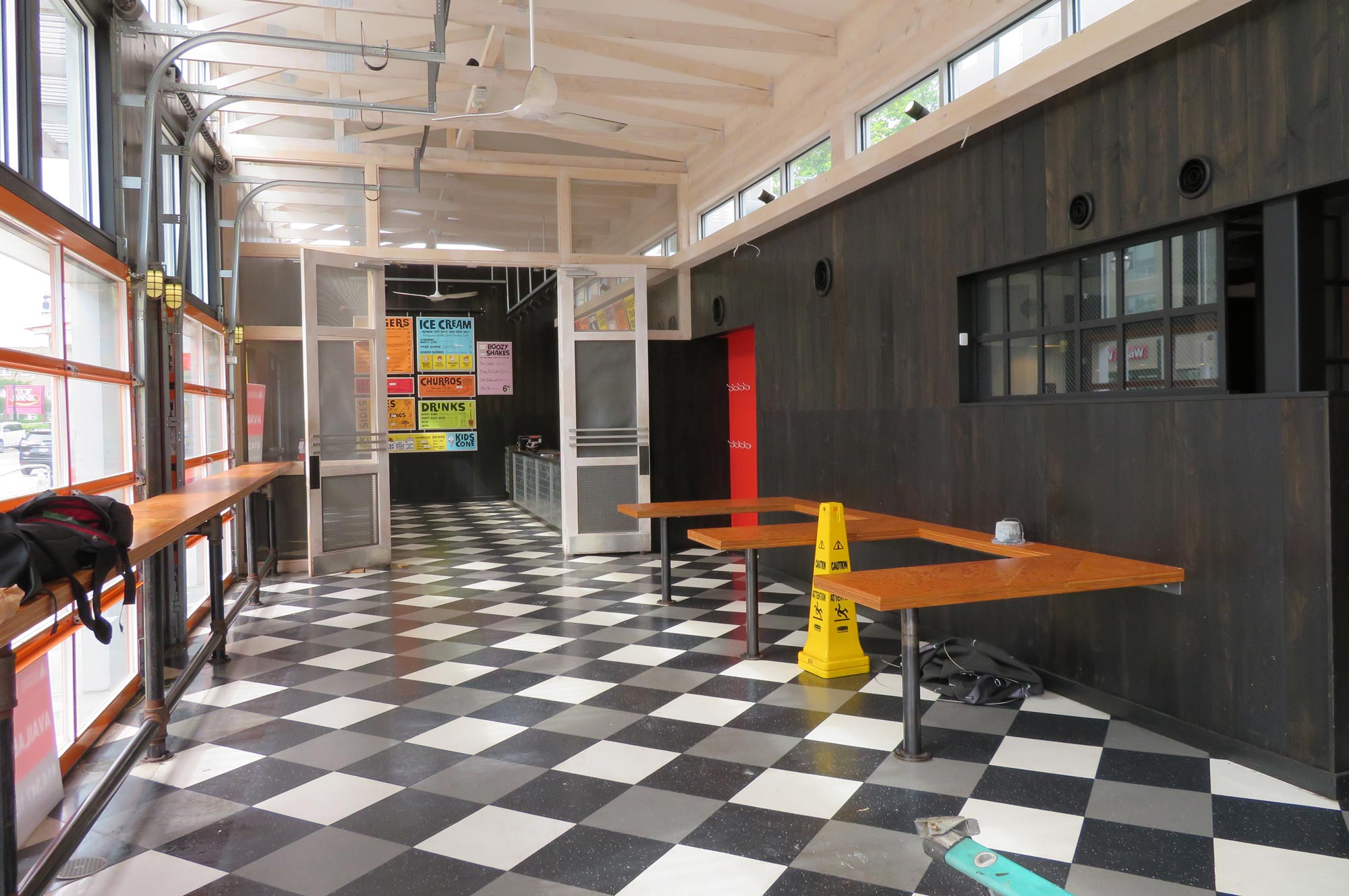
As the novel coronavirus continues to derail restaurants’ plans for 2020, owners and operators may be beginning to contemplate what is in store for their future. Inevitably, some will fail. Others, however, will be ready to expand into new spaces– and with some concepts closing their doors, there will be an increase in vacated real estate open for takeover.
While it is possible to take over an existing restaurant space quickly, effectively and affordably, you have to be careful. Those unfamiliar with this type of development often think they’re getting a great deal because so many required elements of a typical restaurant build-out are existing. Landlords and brokers will emphasize these aspects, highlighting the opportunity to “save.” However, these existing conditions rarely work out the way they’re promoted and can end up costing more in the long-run.
Restauranteurs have the potential to keep these costs down, but in order to do so, it’s important to understand why the costs might not be as low as expected or promoted. There are two key things that influence the costs of developing or taking over an existing restaurant:
Differentiation – a fine line
The former restaurant you’re taking over most likely failed. There is a very thin line that separates the amount of changes required to convince customers that there is a totally new concept and operation in the existing failed space. Finding that line is difficult - falling short can mean continued failure. Blowing past it can mean overspending, making it nearly impossible to make a reasonable return on investment. It is critical to define the minimum amount of changes and investment required to ‘exorcise the demons’ from the failed restaurant and make it clear that a unique, new concept has settled in.
Assumptions
There are many variables associated with redeveloping an existing restaurant. People will often initially assume that much of the equipment, building utilities and existing build-out can be reused because there was a previously operating restaurant in the space. Unfortunately, regardless of what landlords or brokers may tell you, there are too many unknown factors related to reusing existing items: updated building codes, changes in use, condition and useful lifespan of the existing items, etc. Many people may tell you that all of the existing conditions are “grandfathered” because there was an existing restaurant in use prior to you taking possession of the property. Unfortunately, the threshold for reusing existing elements that may not meet current requirements is very low. Every jurisdiction sets their own requirements for allowing non-conforming, existing conditions and these requirements are getting more and more strict.

how to control true costs
Keeping in mind why the costs might be potentially higher than you originally expect, there are three simple things any restaurant owner can do to understand the true costs associated with redeveloping an existing restaurant site and how to control these costs:
Do your homework: As soon as you identify a potential existing restaurant location that you think might work for your concept and execute a Letter of Intent to acquire it, we highly recommend you work with professionals that can help you with thorough due diligence. This may be speaking with your Architect to identify and understand any potential existing areas that are non-compliant with current building, zoning and health codes. It could also be working with your contractors to examine the building systems (especially the HVAC and kitchen exhaust systems) to make sure they’re in good working order with reasonable life left. Do the same with your kitchen equipment vendor on the refrigeration, electrical and mechanical components of the existing foodservice equipment. Don’t make assumptions. Verify as much as possible so that you can clearly ascertain the true costs.
Locate the Documents: There are two different sets of documents that contain critical information and will help with the due diligence above. One set is the Base Building Construction Drawings and the other is the latest Tenant Upfit Construction Drawings. These should include Civil, Landscape, Architectural, Structural, Food Service, Plumbing, Mechanical, Electrical and Fire Protection drawings. Several details could be evident in these drawings that won’t be readily visible in even the most thorough site investigation, like the size of a grease interceptor, under-slab plumbing, exhaust duct sizes, etc. The accuracy of this information can easily swing a project budget almost $100,000 in one direction or another.
In many cases, the only place to find this information is in a detailed set of Construction Drawings. These documents are often available through the landlord or property seller. If not, you can also usually access them for a small fee from the local building department. The really good real estate brokers will make it their responsibility to find and copy these documents for the project team’s use.
Verify the fit: We strongly recommend preparing a “test fit,” or a preliminary layout, as early as possible to determine which aspects of your ideal layout, including cookline, prep kitchen, bar, seating, etc., will fit in this specific location. For example, even though a kitchen exhaust hood may be existing, it might not accommodate your standard equipment line-up. This could either lead to an atypical operation or require significant changes. Either option may be the difference between success or failure.
We also often see an assumed number of seats and / or tables able to fit in a given space based on its square footage, or what was existing. Many times, we find that once a “test fit” is performed and the actual kitchen is laid out in a non-standard shaped space, either more extensive modifications are necessary to get the required seating capacity or the seating capacity becomes secondary to saving money. In either case, the ability to meet the desired ROI is compromised.
These are three simple and very low-cost things you can do to better ascertain the true costs associated with taking over an existing restaurant. Once the true costs are determined, it’s much easier to either negotiate up-front to address these costs or look at other design alternatives to mitigate these costs.
Featured in QSR magazine.
Cleanliness in the Restaurant: Reality & Perception
Just because dine-in business is on hold doesn’t mean your restaurant’s future has to be. Now is the time to get ahead and make sure you are equipped to adequately address what customers will likely be worried about most: restaurant cleanliness and sanitation.
Although celebrity figures like “Bar Rescue” host Jon Taffer recently told “Fox & Friends” viewers that his biggest worry for restaurants is “the premise of spacing continuing into the retail environment,” there’s going to be more that operators will need to evaluate.
We agree that “people aren’t going to want to sit shoulder to shoulder" at first, and that “they are still going to be cautious and want some spacing.” However, we expect the initial reduction in seating capacity to be closer to 25-30%, not 50%. This period will likely last 4-6 weeks, and we expect the seating reduction to create table spacing of approximately 9’-0” on center (from the typical 6’-0” on center).
As restaurants adjust back to a new normal, we expect operators to incrementally add tables and seats back to their longtime standard. We believe this because we know that people are social beings and require social interaction to stay healthy.
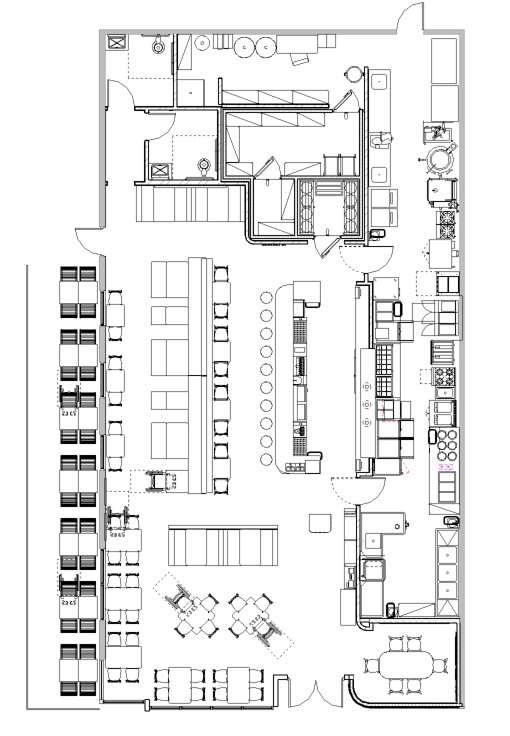
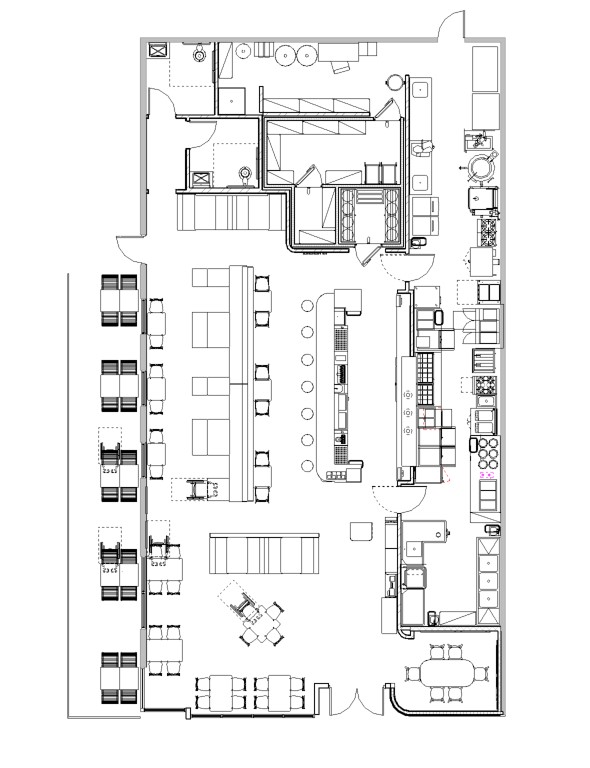
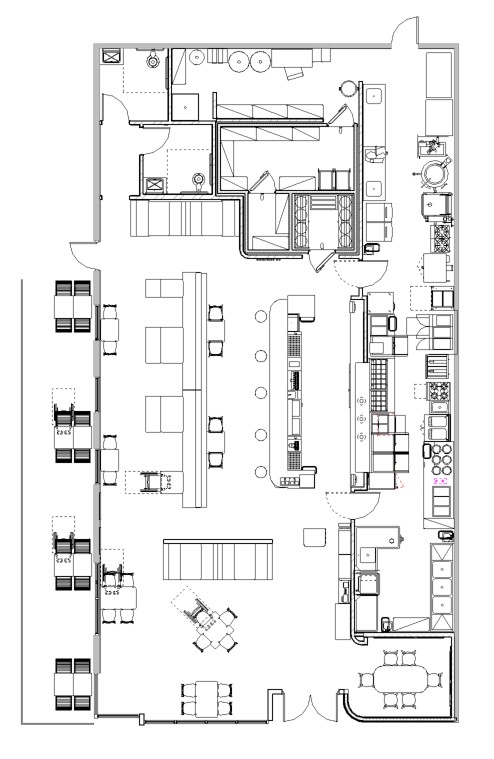
The key here will be providing guests with an environment characterized by both the reality and the perception of cleanliness and healthfulness, even if the restaurant concept is all about indulgence. There is and will continue to be a heightened awareness around how clean surfaces are and a wariness around things people are touching. But what does “clean” really mean?
The Reality of Cleanliness
We know that some viruses, including the novel coronavirus, can live for days on certain surfaces. This makes how, how often, and what surfaces you clean extremely important. Here are the three main levels of cleaning you should be concerned with:
Cleaning – removing physical dirt, debris, soils etc. from the surface. Though it doesn’t kill germs, it is often seen as the most important part of a hygiene process because it impairs environments once conducive to them.
Sanitizing – reducing, not killing, the occurrences and growth of bacteria, viruses and fungi on a surface.
Disinfecting – killing or completely destroying microscopic organisms and pathogens on surfaces. While it does not clean dirt or germs off of the surface, it helps to prevent infection or disease transmission by killing germs.
Sanitary Surfaces
It’s also important to consider surface material. A recent New England Journal of Medicine study shows that the virus that causes COVID-19 can live anywhere from four hours on copper to two to three days on stainless steel and polypropylene plastic (often used to store food). However, antimicrobial technology might be the ticket to reducing the chance of those germs lasting there in the first place.
Antimicrobials can be integrated into products like fabric and plastic, acting as a form of built-in protection. They can also be applied as a coating on metal surfaces like stainless steel. These compounds contain active ingredients, such as silver, that work to suppress and prevent pathogen growth upon contact. Providers like AgION and Microban offer a wide variety of antimicrobial products for equipment used at large in the restaurant industry, such as ovens and HVAC systems.
HACCP-compliant Processes
The ability for germs to live on surfaces for multiple days also emphasizes the need for restaurants to implement processes and procedures based on Hazard Analysis and Critical Control Points, or the HAACP system. HACCP is a methodology that restaurants use to monitor food safety practices by setting processes, responsibilities and record-keeping systems.
One former Darden back-of-house trainer describes it as a “checks and balances system,” allowing businesses to track where health related problems could have stemmed from. HACCP methodology establishes specific expectations for what needs to be cleaned, how it’s to be cleaned, how often it’s to be cleaned, who is responsible when, and more. While it’s customary to have a team of individuals who are responsible for monitoring HACCP compliance and everyone’s health as a whole, it’s important for every employee to be trained on, concerned with and committed to everything on the checklists.
The Perception of Cleanliness -- Visual & Psychological Cues
So, you know how to truly clean, you’ve found antimicrobial products that will do some of the work for you, you’ve established methods to keep the environment safe and you’ve trained your staff on complying with them. Then, a customer walks in the door:
Door handle. Chairback. Tabletop. Menu. That’s four touchpoints in the first seven minutes upon entering your restaurant. And questions linger:
“How clean is this restaurant?”
“Am I safe eating here?”
Using visual and psychological cues to affirm to guests that you have gone above and beyond in promoting restaurant cleanliness is going to be key to eliminating these thoughts. This kind of design doesn’t have to be monumental or cost an arm and a leg, either.
One example would be to put hand sanitizer or wipe dispensers in accessible areas. This not only gives the guest control over their environment (which people naturally like), but also sends the message that cleanliness and sanitation are important to your restaurant. Similarly, you can install foot handles in places like the bathroom door, so guests don’t have to use their clean hands to open it. Again, you are providing the guest with more control over their environment and communicating an effort to reduce the spread of germs.
Additionally, we expect aesthetic trends to scream cleanliness—a cleanliness with warmth rather than sterility. For instance, something more sustainable but reminiscent of the white, butcher paper on wood tables that was popular in the late 1990’s and early 2000’s. From a table covering that is replaced between parties to light-colored quartz bar tops, plan to see the sharp, fresh, white trend reemerge. Though it seemed as though this trend had passed its peak on the trend curve, it will rise again due to how effectively it communicates cleanliness. Dirt or soil is easier to see on a white surface, so if you have a clean, light surface, you’ve already won half the battle.
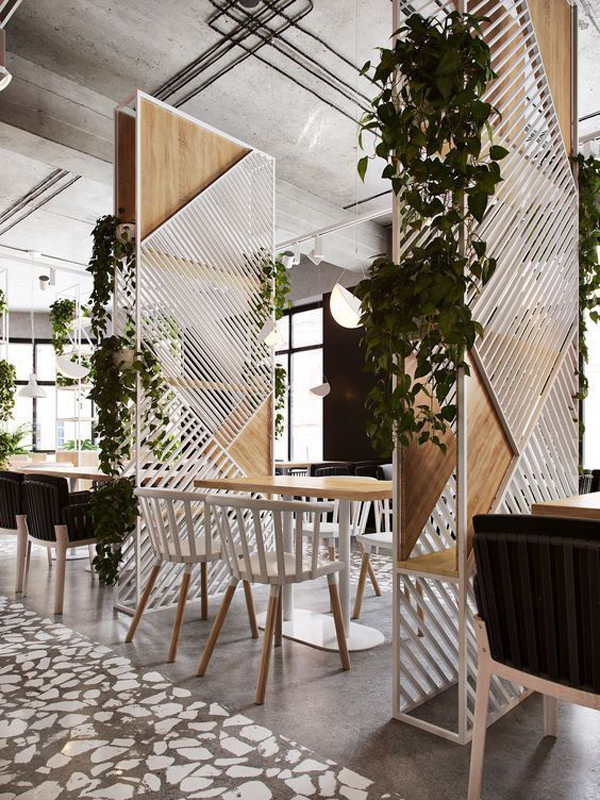
The next half of the battle is communicating sanitation, or that your space is “germ-free.” This can easily be portrayed by hanging up charts that list your HACCP processes and task frequencies. Include boxes for employees to sign off what time they complete specific tasks. By showing guests exactly when an employee cleaned the sink they just used and how often someone cleaned it that day, you are highlighting and celebrating the fact that it is, in fact, clean.

Dining room doors will eventually open to the public again. Now is the time to invest some thought into how you communicate your cleaning habits and how others can and will perceive them. At the end of the day, you want to reassure your guest with messaging that says, “cleanliness and healthfulness is important to us.”
Featured in Modern Restaurant Management magazine.
Foodservice Cleaning and Hygiene in the Age of covid-19
"When we look at a typical food service establishment, there are three distinct areas to address: front of house, back of house and restrooms."
Cleaning your restaurant and keeping it clean is not just something every restaurateur should be doing on a regular basis. It’s now going to become something that customers and guests will expect and local authorities will likely require.
We know that the COVID-19 pandemic wasn’t caused by or transmitted through food, but the foodservice industry may forever feel its impact. Guests will expect a higher level of cleanliness, at least for the short-term, when restaurants reopen for dine-in business in the coming weeks or months.
Midlab, Inc. professional Keith Manning breaks down levels and high-focus areas of cleaning within a restaurant, along with best practices in each to promote health and safety in the foodservice industry.
Manning says that while cleaning and disinfecting have always been important parts of a healthy environment, the emergence of the novel coronavirus emphasizes how critical each is for the long-term health and safety of both foodservice professionals and their guests.
According to Manning, there are 4 aspects of keeping a foodservice establishment clean and sanitary:
- Hand Washing – best way to prevent both your staff and guests from getting sick.
- Cleaning surfaces – removing soils and food sources from surfaces. While cleaning does not kill pathogens, it is the most important part of the hygiene process because it impairs the environment where those pathogens would thrive.
- Sanitizing food contact surfaces – lowering the number of germs on surfaces or objects to a safe level, as judged by public health standards or requirements, but not as thoroughly as a disinfectant.
- Disinfecting touch points – killing pathogens on surfaces or objects. This process does not necessarily clean dirty surfaces or remove germs, but by killing germs on a surface after cleaning, it can further lower the risk of spreading infection.
 Many people will mistakenly use disinfecting interchangeably with sanitizing, but it is important to note two major differences: effectiveness and application. Disinfecting with a product such as the Maxim Facility+ disinfectant cleaner removes more germs than sanitizing, making it more effective in killing pathogens like Covid-19. However, disinfectants are not generally food safe. Due to the high level of actives and detergency in disinfectant products, they must be followed with a potable rinse once the dwell time, or amount of time the surface must remain visibly wet, is achieved.
Many people will mistakenly use disinfecting interchangeably with sanitizing, but it is important to note two major differences: effectiveness and application. Disinfecting with a product such as the Maxim Facility+ disinfectant cleaner removes more germs than sanitizing, making it more effective in killing pathogens like Covid-19. However, disinfectants are not generally food safe. Due to the high level of actives and detergency in disinfectant products, they must be followed with a potable rinse once the dwell time, or amount of time the surface must remain visibly wet, is achieved.
 In contrast, food safe sanitizers like the 430 Maxim Hard Surface Sanitizer Tabletop and Decanter, removes pathogens to a safe level after cleaning and food products may be placed on the surface immediately after the dwell time. Though such sanitizers may not remove pathogens as thoroughly as a disinfectant, the application process is simpler because they do not require a potable rinse.
In contrast, food safe sanitizers like the 430 Maxim Hard Surface Sanitizer Tabletop and Decanter, removes pathogens to a safe level after cleaning and food products may be placed on the surface immediately after the dwell time. Though such sanitizers may not remove pathogens as thoroughly as a disinfectant, the application process is simpler because they do not require a potable rinse.
When we look at a typical food service establishment, there are three distinct areas to address: front of house, back of house and restrooms. Each area plays a vital role to guests and should be kept clean at any and all costs. Especially now. Here’s what Manning also recommends in terms of each:
Front of house
In a typical food service operation, cleaning and sanitizing have always been the rule of thumb. From wiping off gross soil with a wet cloth to cleaning surfaces with an all-purpose or glass cleaner and food-grade sanitizer, this has been the norm for general surface hygiene.
Moving forward, what will we see? We are already seeing more of an emphasis on disinfecting rather than sanitizing as we deal with concerns over more contagious pathogens such as Covid-19. We will likely continue to see more disinfectant usage.
The keys are the staff and guest touch points. Staff should be disinfecting, not just sanitizing, the areas that employees and guests touch frequently. This includes, but is not limited to, all door handles, rails and non-food contact countertops.
Tables are considered a food contact surface, so food safe sanitizers still need to be used between guests. Disinfecting followed by a potable water rinse needs to be done daily.
Back of House
The good news is that heat kills viruses at about 140 degrees Fahrenheit. Therefore, cooking and dishwashing will take care of viruses and bacteria on what you eat and eat on. Again, staff hand washing best practices are another key to reducing the spread.
Slow times are an excellent opportunity to implement best practices. This means using that time to disinfect touch surfaces with dwell time and a potable water rinse on food service areas.
In summary, the simplest and most effective measure for combating the spread of viruses is to keep them away from you. Hand washing and high touch point disinfecting, along with being more aware than normal, will win the day for you.
Restrooms
Restrooms are one of the main danger areas for the spread of infection, not to mention the image of a business in general. Surveys show that dirty restrooms can have a negative impact on guest satisfaction overall.
Disinfecting touch points, such as fixtures, flush handles and dispensers, several times per day is best practice. Deep cleaning, including thoroughly cleaning and disinfecting every major surface and scrubbing down toilet bowls, is best done daily.
People may not continue wiping down their environments with Clorox wipes every 30 minutes, but we do know they will be paying more attention to how clean public areas are, especially restaurants. Legal requirements and regulations will likely increase maintenance standards, and customers will be even more conscious of slightly unkempt bathrooms. Do your research to make sure you’re using A-grade products and practices throughout all areas of your establishment, and be prepared to increase how often you disinfect instead of sanitize. And finally, make sure you teach your employees the difference.
Featured in QSR Magazine.
About Keith:
 Keith Manning is the Vice President of Sales at Midlab, Inc., a cleaning formulations provider focused on solutions that promote clean and safe environments. With over 20 years in the chemical solutions industry, he seeks to help clients solve challenges through safe cleaning solutions that fit the environment.
Keith Manning is the Vice President of Sales at Midlab, Inc., a cleaning formulations provider focused on solutions that promote clean and safe environments. With over 20 years in the chemical solutions industry, he seeks to help clients solve challenges through safe cleaning solutions that fit the environment.


